Skinning Moose Hide
How you remove a moose hide and how you handle your moose meat afterwards will determine if in fact you will enjoy eating it... or not. Here is sound advice on handling your hard earned trophy. One thing I can assure you is dragging your moose through a beaver swamp will not add any good flavors!
Keep your animal carcass free from contamination, such as dirt and hair is super important. Equally important is keeping blow flies off the meat... those little buggers can and will lay their eggs on any exposed meat as soon as they can. If the weather is warm get your meat into a cooler.
After you have completed skinning your moose hide, your meat needs to be stored in a meat cooler (or left outside if it is cold enough). We age our moose meat similar to that of beef to achieve the best in tenderness and flavor.
My butcher (Larry) will not hang "dirty" moose meat (or other wild game) in his Cooler! You might think that this is obvious... but you would be surprised at the condition of moose meat that hunters bring to Larry’s shop. In more than one instance he has told hunters to power wash (low pressure mind you) their meat before he will hang it in the cooler.
That has to be disgusting... it is no wonder why some people are turned off at the taste of wild game!
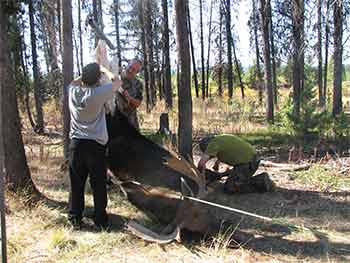
Removing moose hide, just getting started.
Larry tells me stories every year about some hunter who brings in a piece of "Meat" that may resemble some type of wild game? Covered in gravel and dirt, with a mixture of leaves and twigs for good measure... to add flavor and texture he’d surmise. It is no wonder that these peoples friends and family, cringe when invited over for a fun night and barbequed “wild-game”? I think WILD is the operative word here!
Larry invariably comments that our moose looks more like the beef sides he gets from the feed lots in the prairies. We like to eat moose because it tastes good, without the "extras"!
Do you enjoy eating moose meat? Got a moose recipe that is to die for? Please share your moose recipes here.
Would you eat this?Can you imagine opening a package of meat that you just purchased from the local grocer and finding hair or dirt on it. What would you do? You would not eat it would you? I’m sure it would be returned very quickly to the store that sold it, with a stern scolding that this is unacceptable; any future purchases will only be on the condition that this circumstance has been clearly rectified.
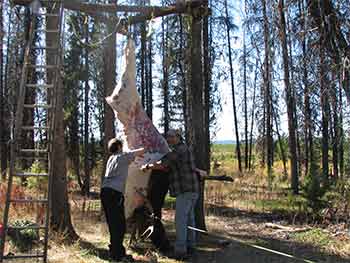
After the moose hide skinning reaches the shoulder area we use the truck to pull the moose up higher to progress with the skinning down toward the neck.
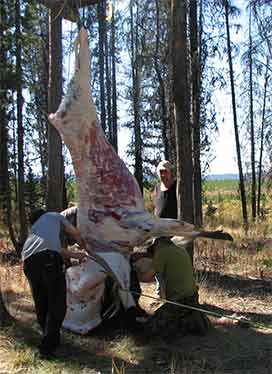
The Moose hide skinned down to the neck, one of the more difficult areas to skin. There is not much fat between the muscles and skin, the skin really seems to cling here. A very sharp knife will aid the moose skinner here.
Why would you, expect any less when you open a package of Moose meat? Meat covered in dirt, pieces of moose hide still attached, needles, leaves, etc. is not going to be good table fair.
In need of a good hunting knife for skinning out your moose? We use two knives, three including the Wyoming knife.
Looking after your future meal starts within minutes of shooting your moose. Consider the following when you are moose hunting if you want to enjoy your moose meat.
Treat your meat like you would expect your favourite meat cutter would, you’ll enjoy it a lot more!
When practical, immediately after ensuring your game is dead, you should field dress the animal (wait if you need to float your moose across a lake [they do float]), but do so as soon as you reach the other shore; this will start the important step of cooling your meat.
There are times when we felt it was better to drag our moose to the nearest road before we cleaned it to prevent the body cavity from filling with debris, this becomes a bit of a judgement call on your part. Although this debris can be washed almost entirely away you will still lose some meat due to dirt contamination, take this into consideration before you clean and or move your game.
Ideally, after you remove the entrails from your game you should remove the moose hide, quarter the carcass and hang it in the shade so the cool air can chill the meat.
Not every situation will require the entrails removed from big game. Consider a mountain hunter, someone who is going to pack his meat out in his backpack (a Badlands 4500 will do the job). He may opt to do the Gutless Field Dressing Method. This involves removal of all the meat from the bones without ever entering the chest cavity.
This sounds straightforward enough, but you are dealing with an animal that likely weighs somewhere about 1200 to 1400 pounds (live weight) and the quarters will weigh about 200 pounds each. You need to think about how you will handle these pieces, how will you get them back to camp? How are you going to prevent wild animals from reaching them? How will you keep the flies off?
We have a container that holds all our shorter pieces of rope (under 50 feet) as well as several meat hooks and pulleys, therefore enabling us to hoist meat out of harm’s way when required. To keep flies away from our meat we have developed a game bag that works better than cheese cloth.
You can purchase packages of cheese cloth game bags that are supposed to fit big game, but no matter which way it is stretched, pulled or cajoled, it is all but impossible to make it fit anything much larger than a rabbit. It seems silly that a package of cheesecloth that is supposed to fit an Elk or Moose will barely fit a small white-tailed deer! What are these manufacturers trying to prove anyway? In order to fit an Elk or Moose you’ll have to purchase at least a half dozen of these? Good luck getting to fit over the ribcage of a Moose!
---Sidebar---
The cheesecloth bags will be useful for those who break the quarters down into more manageable sizes.
---Sidebar---
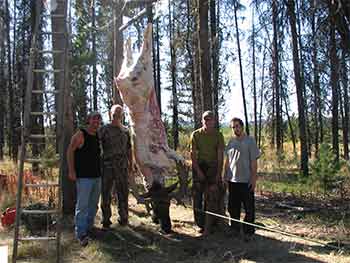
Our moose hide completely removed ready for splitting, before rinsing. Some hunters claim that adding vinegar to your rinse water helps the meat "set-up" and form a skin quicker than if left alone. I admit I have tried it but using vinegar did not seem to make much of a difference to me. Maybe I did not use the correct quantities? Another option I have heard of is to spread black pepper all over the meat.
One of the operations we do during skinning is remove the front legs. Separating the moose knuckle is explained in detail.
As I mentioned we have a better system. Get hold of some old cotton sheets, not flannel, just plain cotton; queen sized preferably. Fold them lengthwise and sew the "L", now create a drawstring in the other edge and you’ll have a bag that is large enough to fit a half of a Moose or Elk. Each hunter in our group has four of these, so we are able to cover the halves when they are hanging in camp and cover the quarters during transportation.
These bags will keep flies away from your meat as well as let it breath while it hangs. Of course it goes without saying you must still remove the moose hide first.
What do you do if you shoot a moose, minutes before dark? Walk away, leave it for morning? I should hope not! You are still required to eviscerate your animal; if you leave it till the next day, it’s going to be a very unpleasant task. Take the time and get the job done, if you must leave it for the next day, prop open the ribcage with a stick so as to let the heat escape as much as possible.
The important thing is to cool your meat as soon as you can.
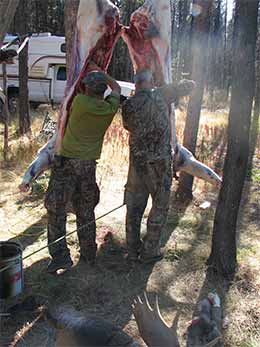
The moose hide skinning is complete and now we are just cleaning up a little.
Once we get our moose back to camp, hung up, quartered and the moose is skinned we go about the task of rinsing. While we were busy skinning the moose hide, two five gallon buckets of water were heating on the fire for use to wash down the moose.
We use warm water as much to clean up the Moose as to help keep our hands warm in cold weather. Sponges, the type you would use to wash your car work very well for this process (only use new unused sponges), they hold a lot of water and the stray moose hairs seem to stick well to them and then fall off in the bucket when you dip your sponge.
This video shows us in action skinning our moose.
If you are looking for moose field dressing click here.
It would seem that we humans are not the only ones that like to eat moose meat, wolves do too! Had an experience with a wolf? Got a picture of one? Tell us about it. We all like to see photos of Wolves. If you have one you would like to share with others please do so by clicking here.
Want to learn how to hunt moose? Or are you wanting to increase your moose hunting skills?
Look no further!
Our moose hunting tips book is written with
not just the novice in mind, there are tips in the book that even the
most seasoned moose hunter will find of value.
The book includes 57 chapters, with more than 150 pages of information, jam packed with tips, techniques and discussions - The Ultimate Guide to Moose Hunting!
And don't forget to order one of our Fiberglass Moose Calls. In stock and ready to ship.
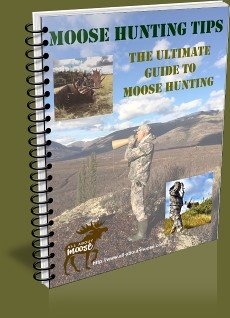
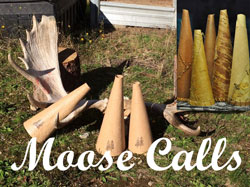
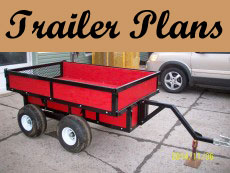
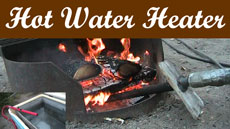
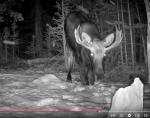
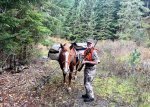
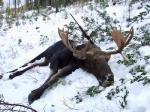
Comments
Have your say about what you just read! Leave me a comment in the box below.